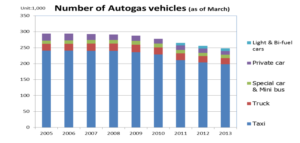Autogas market developments in Japan
 Makoto Arahata, Overseas Business Manager, Japan LP Gas Association, reports on the latest development in Autogas in Japan.
Makoto Arahata, Overseas Business Manager, Japan LP Gas Association, reports on the latest development in Autogas in Japan.
Market trends
Autogas remains an important component of the Japanese LP Gas market even though demand for Autogas has been declining. This trend will probably not change much in the foreseeable future either. The total demand for LP Gas in Japan has been in continuous decline since 1996. Demand for Autogas peaked at 1 642 million tonnes in 2004 and dropped to 1 275 million tonnes in 2011. The demand for Autogas was about 9.2% of the total demand for LP Gas in 2004 and it fell to 7.8% in 2011. In March 2013, there were 248 000 Autogas vehicles on the road, including 3 000 light vehicles with an engine capacity of less than 660 cc and 5 000 bi-fuel cars (these vehicles were not included in the total until 2011). The trend and breakdown in the Autogas vehicle fleet is shown in the chart below.
Market trends
Autogas remains an important component of the Japanese LP Gas market even though demand for Autogas has been declining. This trend will probably not change much in the foreseeable future either. The total demand for LP Gas in Japan has been in continuous decline since 1996. Demand for Autogas peaked at 1 642 million tonnes in 2004 and dropped to 1 275 million tonnes in 2011. The demand for Autogas was about 9.2% of the total demand for LP Gas in 2004 and it fell to 7.8% in 2011. In March 2013, there were 248 000 Autogas vehicles on the road, including 3 000 light vehicles with an engine capacity of less than 660 cc and 5 000 bi-fuel cars (these vehicles were not included in the total until 2011). The trend and breakdown in the Autogas vehicle fleet is shown in the chart below.
New grant by the Japanese government
LP Gas proved itself as a reliable source of energy and as fuel for land transportation at the time of the terrible tsunami that struck Japan in 2011. To ensure that LP Gas provides a reliable source of energy, it is important that the LP Gas supply chain keeps functioning even during such a natural disaster. LP Gas filling stations are one of the core facilities to maintain the supply chain of LP Gas. Autogas vehicles played a vital role in transporting emergency supplies to evacuees from the disaster area as well as LP Gas cylinders to those who needed them. In recognition of the important role that Autogas plays during natural disasters, the government has decided to provide a grant amounting to 250 million yen, which will be used to finance the purchase of more than 1 000 Autogas vehicles for the car pools of the LP Gas filling stations.
Japanese OEMs
Toyota, which has manufactured Autogas taxis for many years, has reportedly decided to stop supplying conventional Autogas vehicles to the Japanese taxi industry by 2018, because the vehicles would not be able to meet the regulatory requirement recently imposed by the Japanese government. These include the risk of harm to pedestrians and passengers in the event of an accident. But new Autogas models are set to fill the gap. Nissan’s “Vanette 200” taxi cab (see the photo below) has been modified so that it can run on Autogas; the Autogas version became available in Japan in April 2013. The Nissan “Vanette 200” taxi cab that runs on gasoline was accepted by the Japanese government as meeting the criteria for the so-called “Universal Design Taxi cab”, which can accommodate passengers in a wheelchair together with other passengers in the same cabin, in April 2012.
Some Japanese taxi companies have already started introducing the “Vanette 200” into their car pools. The car was selected as New York City “Taxi of Tomorrow” in 2011. It features a rear-entry ramp and an industry-first integrated restraint system that provides safe and quick securing of wheelchairs. Nissan is looking to sell “Vanette 200” in other markets too. Nissan “Vanette 200” on the streets of New York Recently, it was reported that Toyota would introduce van-type hybrid vehicles fuelled by Autogas onto the Japanese market in 2016. These vehicles should qualify as “Universal Design Taxi-cabs” by the Japanese government like the “Nissan Vanette 200”. A source has reported that the fuel efficiency of the new hybrid taxi vehicles will be twice as good as that of the present. The Autogas version of the Nissan “Vanette 200” Nonetheless, the introduction of hybrid systems to improve the fuel efficiency of vehicles will generally make Autogas less attractive to taxi operators, as the cost savings from using cheaper Autogas will diminish. However, by communicating globally with our colleagues through the WLPGA platform, we will continue to seek ways of developing new Autogas markets in Japan, like the market for private motorists.
For more information about Autogas in Japan, please contact Makoto Arahata by email at: m-arahata@j-lpgas.gr.jp


